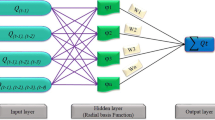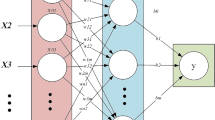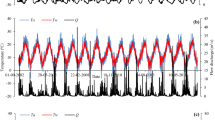Abstract
Rainfall impacts local water quantity and quality. Accurate and timely prediction of rainfall is highly desirable in water management and hydrogeologic hazards mitigation, which is critical for the environmentally sustainable development. Previous rainfall prediction processes are complex and computationally costly for its intrinsic high uncertainty and variability. In this paper, a data-driven approach is applied to predict the rainfall based on historic data via time-series modeling and optimally pruned extreme learning machine (OP-ELM). The rainfall datasets collected from six counties within Three Georges Reservoir are utilized as case studies in this research, first, the rainfall data is pre-processed with outlier removal and missing value imputation, and the monthly ahead difference is computed based on the instant average of monthly rainfall. Next, the autocorrelation function and partial autocorrelation function were computed and the Ljung–Box test statistic is utilized to explore the significance of the historic lagged-series. All the statistically significant historic lags are selected as inputs for prediction algorithms. Last, an OP-ELM algorithm is developed to predict the monthly rainfall with tenfold cross validation. Four activation functions: the sigmoid, sine, hardlim, and radial basis function, are considered in the OP-ELM. The prediction performance is evaluated with metrics including mean absolute error, mean absolute percentage error, root mean square error, and max error rate. Overall, the computational results indicate the proposed framework outperforms the other benchmarking machine learning algorithms through six case studies in Three Gorges Reservoir, China.






Similar content being viewed by others
References
Adhikary S, Muttil N, Yilmaz A (2016) Genetic-programming based ordinary kriging for spatial interpolation of rainfall. J Hydrol Eng ASCE 14:04015062
Camps-Valls G, Martín-Guerrero JD, Rojo-Alvarez JL, Soria-Olivas E (2004) Fuzzy sigmoid kernel for support vector classifiers. Neurocomputing 62:501–506
Cawley GC, Talbot NL (2003) Efficient leave-one-out cross-validation of kernel fisher discriminant classifiers. Pattern Recognit 36(11):2585–2592
Chattopadhyay S, Chattopadhyay G (2008) Identification of the best hidden layer size for three-layered neural net in predicting monsoon rainfall in India. J Hydroinform 10(2):181–188
Chattopadhyay G, Midya SK, Chattopadhyay S (2020) Information theoretic study of the ground-level ozone and its precursors over Kolkata, India, during the summer monsoon. Iran J Sci Technol Trans Sci. https://doi.org/10.1007/s40995-020-01007-x
Deo RC, Şahin M (2015) Application of the extreme learning machine algorithm for the prediction of monthly Effective Drought Index in eastern Australia. Atmos Res 153:512–525
Esteves JT, de Souza Rolim G, Ferraudo AS (2019) Rainfall prediction methodology with binary multilayer perceptron neural networks. Clim Dyn 52(3–4):2319–2331
Grigorievskiy A, Miche Y, Ventelä AM, Séverin E, Lendasse A (2014) Long-term time series prediction using OP-ELM. Neural Netw 51:50–56
He Y, Kusiak A (2018) Performance assessment of wind turbines: data-derived quantitative metrics. IEEE Trans Sustain Energy 9(1):65–73
He Y, Kusiak A, Ouyang T, Teng W (2017) Data-driven modeling of truck engine exhaust valve failures: a case study. J Mech Sci Technol 31(6):2747–2757
He Y, Fei F, Wang W, Song X, Sun Z, Baek S (2018) Predicting manufactured shapes of a projection micro-stereolithography process via convolutional encoder-decoder networks. In: Proceedings of ASME 2018 international design engineering technical conferences & computers and information in engineering conference, Quebec City, Quebec, Canada
Hearst MA, Dumais ST, Osuna E, Platt J, Scholkopf B (1998) Support vector machines. IEEE Intell Syst Their Appl 13(4):18–28
Horikawa SI, Furuhashi T, Uchikawa Y (1992) On fuzzy modeling using fuzzy neural networks with the back-propagation algorithm. IEEE Trans Neural Netw 3(5):801–806
Huang GB, Chen L, Siew CK (2006) Universal approximation using incremental constructive feedforward networks with random hidden nodes. IEEE Trans Neural Netw 17(4):879–892
Kasun LLC, Zhou H, Huang GB, Vong CM (2013) Representational learning with extreme learning machine for big data. IEEE Intell Syst 28(6):31–34
Kişi Ö (2009) Wavelet regression model as an alternative to neural networks for monthly streamflow forecasting. Hydrol Process Int J 23(25):3583–3597
Labat D, Ababou R, Mangin A (2000) Rainfall–runoff relations for karstic springs. Part II: continuous wavelet and discrete orthogonal multiresolution analyses. J Hydrol 238(3–4):149–178
Lee T (2016) Wild bootstrap Ljung–Box test for cross correlations of multivariate time series. Econ Lett 147:59–62
Li H, Xu Q, He Y, Deng J (2018) Prediction of landslide displacement with an ensemble-based extreme learning machine and copula models. Landslides 15(10):2047–2059
Li H, Xu Q, He Y et al (2020) Modeling and predicting reservoir landslide displacement with deep belief network and EWMA control charts: a case study in Three Gorges Reservoir. Landslides 17(3):693–707
Liang NY, Huang GB, Saratchandran P, Sundararajan N (2006) A fast and accurate online sequential learning algorithm for feedforward networks. IEEE Trans Neural Netw 17(6):1411–1423
Liu H, Tian HQ, Li YF (2012) Comparison of two new ARIMA-ANN and ARIMA-Kalman hybrid methods for wind speed prediction. Appl Energy 98:415–424
Matsuda A, Kurosaki T (2019) Demand for temperature and rainfall index insurance in India. Agric Econ 50(3):353–366
McLeod A, Li W (1983) Diagnostic checking ARMA time series models using squared residual autocorrelations. J Time Ser Anal 4(4):269–273
Miche Y, Sorjamaa A, Bas P, Simula O, Jutten C, Lendasse A (2010) OP-ELM: optimally pruned extreme learning machine. IEEE Trans Neural Netw 21(1):158–162
Mohammed AA, Minhas R, Wu QJ, Sid-Ahmed MA (2011) Human face recognition based on multidimensional PCA and extreme learning machine. Pattern Recognit 44(10–11):2588–2597
Mugume I, Mesquita M, Bamutaze Y, Ntwali D, Basalirwa C, Waiswa D, Reuder J, Twinomuhangi R, Tumwine F, Ngailo TJ, Ogwang B (2018) Improving quantitative rainfall prediction using ensemble analogues in the tropics: case study of Uganda. Atmosphere 9(9):328
Ohba M, Sugimoto S (2019) Differences in climate change impacts between weather patterns: possible effects on spatial heterogeneous changes in future extreme rainfall. Clim Dyn 52:4177–4191
Ouyang T, Zha X, Qin L, Xiong Y, Xia T (2016) Wind power prediction method based on regime of switching kernel functions. J Wind Eng Ind Aerodyn 153:26–33
Ouyang T, He Y, Li H, Sun Z, Baek S (2019) Modeling and forecasting short-term power load with copula model and deep belief network. IEEE Trans Emerg Top Comput Intell 3(2):127–136
Pal S, Dutta S, Nasrin T et al (2020) Hurst exponent approach through rescaled range analysis to study the time series of summer monsoon rainfall over northeast India. Theor Appl Climatol 142:581–587
Pankratz A (1983) Forecasting with univariate Box–Jenkins method. Wiley, New York
Petković MD, Stanimirović PS (2011) Iterative method for computing the Moore–Penrose inverse based on Penrose equations. J Comput Appl Math 235(6):1604–1613
Ray SN, Chattopadhyay S (2021) Analyzing surface air temperature and rainfall in univariate framework, quantifying uncertainty through Shannon entropy and prediction through artificial neural network. Earth Sci Inf. https://doi.org/10.1007/s12145-020-00555-5
Ray S, Bose S, Chattopadhyay S (2021) A markov chain approach to the predictability of surface temperature over the northeastern part of India. Theor Appl Climatol 143:861–868. https://doi.org/10.1007/s00704-020-03458-z
Similä T, Tikka J (2005) Multiresponse sparse regression with application to multidimensional scaling. In: International conference on artificial neural networks. Springer, Berlin, pp 97–102
Sivapragasam C, Liong SY, Pasha MFK (2001) Rainfall and runoff forecasting with SSA-SVM approach. J Hydroinform 3(3):213–217
Suresh S, Babu RV, Kim HJ (2009) No-reference image quality assessment using modified extreme learning machine classifier. Appl Soft Comput 9(2):541–552
Tian X, Veldhuis M, Schleiss M et al (2019) Critical rainfall thresholds for urban pluvial flooding inferred from citizen observations. Sci Total Environ 689:258–268
Toth E, Brath A, Montanari A (2000) Comparison of short-term rainfall prediction models for real-time flood forecasting. J Hydrol 239(1–4):132–147
Wang Y, Cheng C, Xie Y et al (2017) Increasing trends in rainfall–runoff erosivity in the source region of the Three Rivers, 1961–2012. Sci Total Environ 592:639–648
Wu J, Long J, Liu M (2015) Evolving RBF neural networks for rainfall prediction using hybrid particle swarm optimization and genetic algorithm. Neurocomputing 148:136–142
Wu Z, Zhou Y, Wang H, Jiang Z (2020) Depth prediction of urban flood under different rainfall return periods based on deep learning and data warehouse. Sci Total Environ 716:137077
Xu Q, Li H, He Y, Liu F, Peng D (2019) Comparison of data-driven models of loess landslide runout distance estimation. Bull Eng Geol Environ 78(2):1281–1294
Yen M, Lui D, Hsin Y, Lin C, Chen C (2019) Application of deep learning for the prediction of rainfall in southern Taiwan. Sci Rep 9:12774
Acknowledgements
We are immensely grateful to the suggestions and help from Andrés Felipe Alonso Rodriguez.
Author information
Authors and Affiliations
Corresponding author
Additional information
Publisher's Note
Springer Nature remains neutral with regard to jurisdictional claims in published maps and institutional affiliations.
Rights and permissions
About this article
Cite this article
Li, H., He, Y., Yang, H. et al. Rainfall prediction using optimally pruned extreme learning machines. Nat Hazards 108, 799–817 (2021). https://doi.org/10.1007/s11069-021-04706-9
Received:
Accepted:
Published:
Issue Date:
DOI: https://doi.org/10.1007/s11069-021-04706-9




